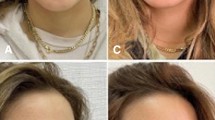Abstract
Injecting Restylane into the lower eyelid (to correct a tear trough or orbitomalar groove) is fraught with potential complications, such as bruising, lumpiness, and contour irregularities. Nonetheless, it can be done and good results can be achieved.
You have full access to this open access chapter, Download chapter PDF
Similar content being viewed by others
Keywords
Injecting Restylane into the lower eyelid (to correct a tear trough or orbitomalar groove) is fraught with potential complications, such as bruising, lumpiness, and contour irregularities. Nonetheless, it can be done and good results can be achieved.
Adjust patients’ expectations, and tell them that they will most likely have some bruising, even though they do not have bruising in the lower face with Restylane (Fig. 148.1).
(a) Patient post lower blepharoplasty with fat repositioning. The patient declined midfacial liposculpture. Note significant midface volume loss and prominent residual tear trough. (b) Following three sessions of midfacial fillers and tear trough treatment spread over months (most recently with 4 vials of Restylane), the patient achieves appropriate facial volumization and correction of the tear trough
I only use a topical anesthetic—usually ELA-Max cream. I always inject very deep along the inferior orbital rim. Inject very small aliquots (0.02 ml). While injecting, keep one finger pressed inside the inferior orbital rim to prevent the Restylane from traveling superior to the orbital rim. After each injection, apply pressure to the area to tamponade bleeding and prevent bruising. I inject greater volumes into the cheek (inferior to the orbitomalar groove or tear trough) because expanding the cheek will “push” fat superiorly toward the lid area. This treatment is much more time-consuming than Restylane injections in the nasolabial folds or marionette lines.
Author information
Authors and Affiliations
Editor information
Editors and Affiliations
Rights and permissions
Copyright information
© 2015 Springer Science+Business Media New York
About this chapter
Cite this chapter
Hofmann, R.J. (2015). Restylane Injection for the Lower Eyelid Tear Trough. In: Hartstein, MD, FACS, M., Massry, MD, FACS, G., Holds, MD, FACS, J. (eds) Pearls and Pitfalls in Cosmetic Oculoplastic Surgery. Springer, New York, NY. https://doi.org/10.1007/978-1-4939-1544-6_148
Download citation
DOI: https://doi.org/10.1007/978-1-4939-1544-6_148
Published:
Publisher Name: Springer, New York, NY
Print ISBN: 978-1-4939-1543-9
Online ISBN: 978-1-4939-1544-6
eBook Packages: MedicineMedicine (R0)





